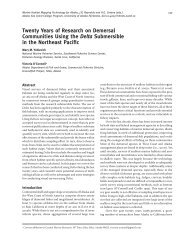724_Final Report.pdf - North Pacific Research Board
724_Final Report.pdf - North Pacific Research Board
724_Final Report.pdf - North Pacific Research Board
You also want an ePaper? Increase the reach of your titles
YUMPU automatically turns print PDFs into web optimized ePapers that Google loves.
Abstract<br />
Fatty acid (FA) signature analysis has been used to study trophic relationships and foraging ecology in<br />
marine ecosystems. This powerful method provides information about diets over a longer period of time<br />
(e.g., 2-4 weeks) rather than just the most recent meal. Using a comprehensive database of diet FA<br />
signatures and accounting for consumer FA metabolism, it is possible to estimate the proportions of diet<br />
items in the consumer diet using quantitative FA signature analysis (QFASA). However, before applying<br />
QFASA to free ranging populations, ideally, a captive study is performed to assess the quantitative<br />
characteristics of the study species’ FA metabolism. We conducted feeding experiments to validate the<br />
use of QFASA in captive spectacled (N=8) and Steller’s eiders (N=8) as a minimally invasive method for<br />
studying the diets of these threatened birds. From the long-term feeding period, we assessed the<br />
quantitative characteristics of FA deposition and developed calibration coefficients (CCs) for individual<br />
FAs to account for eider lipid metabolism. We then tested the model and CCs by estimating the diets of<br />
the captive eiders. Our results revealed that QFASA accurately indicates diet and diet switches in captive<br />
eiders for these diet items. QFASA also confirmed that complete FA turnover of the new introduced diets<br />
was not complete by 21 or 29 days, and that diets could be estimated over an extended period of > 29<br />
days. Thus, our understanding of diet can be backtracked to more than a month in feeding eiders. We<br />
conclude that applying QFASA techniques to eiders in the wild has the potential to provide valuable<br />
information about their diets at different life history stages.<br />
Key Words: fatty acids, diet, foraging ecology, Somateria fischeri, Polysticta stelleri<br />
8



